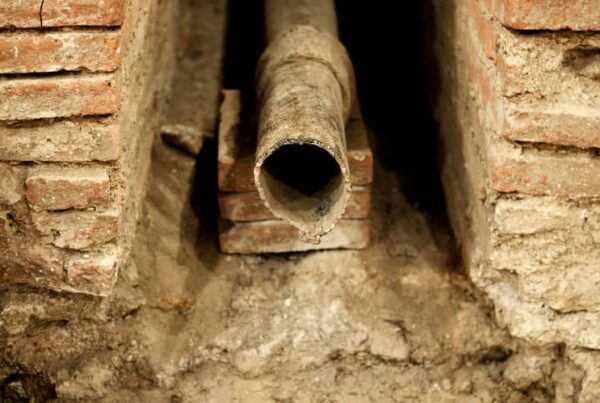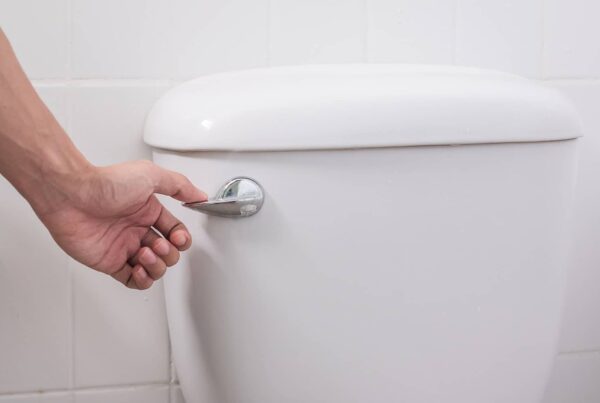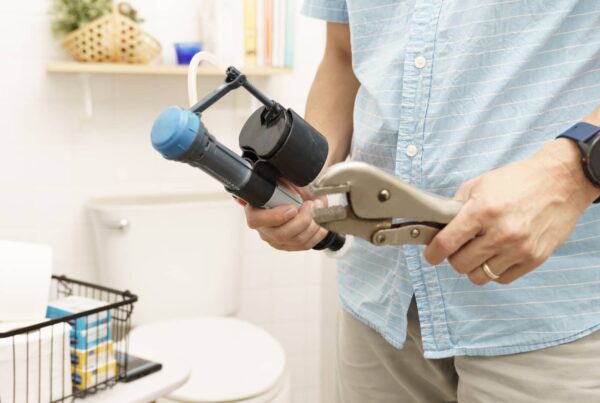
Water heater life expectancy is about 8-12 years. However, your water heater can start leaking before then. In this post, we are going to cover the complete guide on what to do if you have a water heater leaking.
Why Does My Water Heater Leak?
The most common reasons for water heater leaking are age and high water pressure.
Overtime, the natural minerals in water can create deposits and calcium build up inside the water heater. Then, the tank can rust and corrode. This is a natural process.
On the other hand, if your water pressure is too high, this can cause too much strain on the TPR valve, drain valve, or other components.
Sometimes, other components can just become faulty which may lead to a leak at the supply pipes or elsewhere.
Here’s what to do about your water heater leaking.
Step 1: Shut Off Water Supply, Power, & Gas
The first step in any water leak situation is to shut off the water supply. This will lessen any water damage as you find the source and make repairs.
Your water supply can be stopped in many places depending on your home. The easiest place is the pipe that leads water into your water heater. However, you can also shut-off your water at your main valve or water meter if you cannot find the valve just before your water heater.
Take a look at the images below to find these valves. Keep in mind, cold water goes into the water heater and then hot water leaves so your water shutoff should be on the cold side (inlet) which is typically on the right. Use your hand to feel the temperature of the pipe and ensure it is the inlet.



After you have shutoff the water, head to your electrical panel and turn off the water heater breaker.

Finally, if you have a gas water heater, you should shut off the gas to your home. After the water, gas, and power are shut off to the water heater, you can begin finding the water heater leak and repair it.
Step 2: Draining the Water Heater
If your leak is bad enough, you may want to consider draining the water heater to prevent further water damage.
To do this, simply connect a hose to the drain valve at the bottom of the water heater. Then, lead the hose outside the home. Be sure that gravity will naturally allow the water heater to drain.
Next, use a flat head screwdriver to loosen the drain valve and empty the water heater.
Allow the water to fully drain.
This maintenance should be completed at least once per year to remove any sediment build up.
Step 3: Finding The Water Heater Leak & Repairs
By this point, you should see your water heater leaking and know if it is a lot or a small drip. In most cases, water heater leaking is at the bottom, however, it could also be other places. Before moving forward, take a look at this diagram to understand where your water heater leak may be.

Water Heater Leaking At The Bottom
As mentioned, most water heater leaks are at the bottom of the water heater in the drain pan.
Your water heater may not have a drain pan, and that’s okay! Just know for your next water heater, you should have a drain pan to catch the water leak. In addition you should have a PVC drain pipe connecting the water heater drain pan to the exterior of the home. You can see in the image above, the drain pan has a PVC pipe that drains to the lowest part of the garage floor.

If your water heater is leaking from the bottom like the image above, most likely your water heater is older and rusted. Therefore, you would need a new water heater since the rust cannot be repaired. We recommend contacting a plumber to replace your water heater for you. However, replacing a water heater can be done on your own if you are handy.
Water Heater Leaking At TPR Valve
If your water heater is leaking from the TPR Discharge Tube, as seen in the image below, this is typically an easy fix by replacing your TPR Valve.

Water Heater Leaking From The Top Pipes
If your water heater is leaking from the top pipes/connections where your inlets/outlets are, most likely you will just have to redo those connections. If this is something you are comfortable with, you can do this on your own. Use this video below for guidance.
Water Heater Leaking From Drain Valve
If your water heater is leaking from your drain valve, this is usually an easy fix by tightening the drain valve with a wrench. If that does not work, you may need to replace the drain valve.
Here’s how to do that!
Water Heater Maintenance & Preventing Another Leak
After fixing this leak, you will want to complete some steps to prevent another water heater from leaking.
Drain Your Water Heater Yearly
The first thing you should remember to do is to drain your water heater yearly. To do this, simply connect a hose to the drain valve at the bottom of the water heater. Then, lead the hose outside the home. Be sure that gravity will naturally allow the water heater to drain. Next, use a flat head screwdriver to loosen the drain valve and empty the water heater.
Check Your TPR Valve & Discharge Tube For Leaks
The end of your discharge tube should easily be visible. You should monitor this area for leaks every so often and repair as needed. If your TPR valve leaks, it is a sign that something is wrong.
You can also watch this video for more information
Drain Pan & Pipe
Ensure you have a proper drain pan and pipe that leads outside the home. In the case your water heater leaks again, you can count on your drain pan and pipe to carry the water out of your home and preventing water damage.
Final Thoughts
Water heater leaking is common and is usually an easy fix. In most cases, you will have to replace the water heater. However, following these steps might lead you to find your water heater leak was really an easy repair!
If you have additional questions, comment below!



